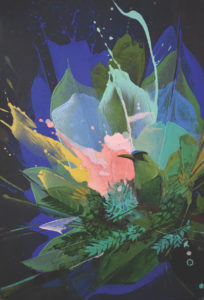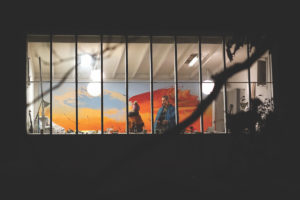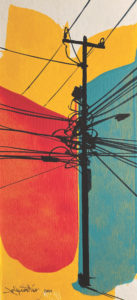
Felipe Ortiz stands on the deck of Wellfleet’s Lechay House, the modernist former home of the late painter James Lechay. The view stretches across the pine forest all the way to the bay. “I cannot believe how lucky I am to be here,” Ortiz says, his gaze following the flight of a hawk soaring high above the treetops, then diving down to pursue a crow.
In Lechay’s art studio, Ortiz is painting bold, bright hues onto a canvas that spans a wall. In one corner, the sky burns red and orange above a shadow of land that locals would recognize as Great Island. From the etched lines of illegible writing in the center of the painting, a burst of black bird silhouettes scatter.

“There is a lot of Cape Cod in here,” says Ortiz. “The shapes of sand dunes, the sea, the sunsets and sunrises. And then, there are details that are more specific to me — hummingbirds and other migratory and tropical species.”
Ortiz was born in the city of Cali, Colombia in 1985 and emigrated to the U.S. with his parents as a teenager. Now living in Boston, Ortiz has been summering on the Outer Cape since 2006, but this is the first time he has come here during the off-season to work.
“It is very inspiring to be in James Lechay’s studio,” Ortiz says. “The creative energy is evident in a place like this, and I feel we would have been friends. I feel honored to create in his space.”
In September, smaller-scale paintings by Ortiz of light posts were exhibited at Eastham’s Longstreet Gallery and were a big success. They were created during his summers here.
“We see light posts everywhere,” Ortiz says. “They are in every landscape, rural or urban, throughout the world. They serve as connectors, transmitting energy from one place to another.”
Themes of connection, migration, and the ability of species — including humanity — to adapt to new environments are common threads in Ortiz’s work.
“Drawing was always part of my life when I was a kid,” Ortiz says. “I felt isolated when I came here because of the language and culture barrier, and, because of this, I started to pay more attention to my drawings.”

He enrolled in a ceramics program at Alfred University in New York but, after a year there, transferred to MassArt, where he graduated with a B.F.A. in painting. But perhaps the biggest influence on his art is his native country, especially since his first visit back, 14 years after moving here.
“I had been painting cityscapes because that was my environment, and my palette had grown muddy and muted,” Ortiz says. “When I arrived in Colombia, I immediately had the sensation that no time had gone by at all since I left.”
Five days into his visit, tragedy struck: his older brother, Juan Pablo, who had stayed in Colombia when the rest of the family emigrated, was killed in a diving accident that Ortiz witnessed.
“Coming back, rediscovering my culture and identity, then watching my brother die, all within a few days, caused an overload of emotion in me,” Ortiz says. “I was filled with rage. And everything I was seeing down there was exploding with a vibrancy of color like I had not experienced in a long time. It was all very extreme. I started throwing paint, making splashes. When I looked at the splashes afterward, I started recognizing shapes on the canvas, almost like when you’re looking up at the sky and the clouds take on different shapes.”
This led to a lasting change in Ortiz’s practice. He’ll often start by hurling buckets of stage paint — as he did to the canvas he’s working on in Wellfleet — and then develop his imagery from there. The result often includes tropical flora and fauna.

Ortiz has also been influenced by traditions of public art of Colombia, where outdoor murals transmit messages of hope, of political protest, or of the need to protect indigenous cultures.
“To me this was the most beautiful thing,” he says. “I had come from the more commercial approach to art here in the U.S., but down there, you can do art just because you want to do it, and because people want you to create art for their communities.”
Not long after his brother’s death, Ortiz was invited to a “painting jam,” in which a group of friends create a work of public art together. The community that invites the artists feeds them while they paint. Ortiz’s first jam was a mural on a cemetery wall, and he painted his part in Juan Pablo’s memory. It’s his only mural to date that includes a human figure.
Ortiz says that he works to fulfill Juan Pablo’s belief in his talent. During his brother’s first visit to the U.S., in 2008, Ortiz says Juan Pablo told him: “ ‘Come on, is this the best you can do?’ He knew that I could do better.”
Many of Ortiz’s paintings include messages to Juan Pablo etched in black paint, then covered by added layers. “The way my brother lived and died was an expression of his belief that if you’re going to do something, you better do it a hundred percent and with all the love you’ve got,” Ortiz says. “If not, what’s the point?”
